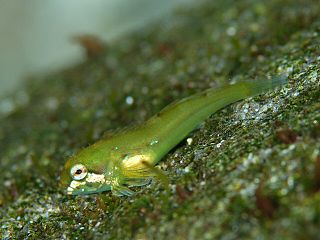
The snubnose sculpin is a species of marine ray-finned fish belonging to the family Cottidae, the typical sculpins. This fish is found in the eastern Pacific Ocean.
Antipodocottus galatheae, the Galathea sculpin, is a species of marine ray-finned fish belonging to the family Cottidae, the typical sculpins. This species found on the continental shelf around New Zealand. It has also been recorded off Tasmania, New South Wales and Queensland.

The Norway bullhead is a species of marine ray-finned fish belonging to the family Cottidae, the typical sculpins. This species is found in the northeastern Atlantic Ocean.
The Andriyashev largeheaded sculpin is a species of marine ray-finned fish belonging to the family Cottidae, the typical sculpins. This species is found in the northwestern Pacific Ocean. This monospecific genus, and therefore this species, are known from a single specimen, the holotype. This was collected from off Simushir Island in the Kuril Islands at a depth of 100 metres (330 ft). That specimen had a total length of 23.6 cm (9.3 in) long. FishBase classifies this taxon within the Cottidae but other authorities classify it within the subfamily Psychrolutinae of the family Psychrolutidae. The genus name Andriashevicottus includes a patronym, the person honoured was not identified by the describer Fedorov, however, it is almost certainly the Soviet ichthyologist Anatoly Petrovich Andriashev, the patronym is suffixed with Cottus, the type genus of the family Cottidae. The specific name megacephalus means "big head".

Archistes is a genus of marine ray-finned fishes belonging to the family Cottidae, the typical sculpins. the two species in this genus are found in the northern Pacific Ocean.

Artediellus is a genus of marine ray-finned fishes belonging to the family Cottidae, the typical sculpins. Most of the fishes in this genus are found in the northern Pacific Ocean but they also occur in the Arctic and North Atlantic Oceans.

The rosylip sculpin is a species of marine ray-finned fish belonging to the family Cottidae, the typical sculpins. This species is found in the eastern Pacific Ocean from Alaska to central California where it is an inhabitant of tidepools and other intertidal environments. This species grows to a length of 15 centimetres (5.9 in) TL. This species is the only known member of its monospecific genus Ascelichthys.

Bero elegans is a species of marine ray-finned fish belonging to the family Cottidae, the typical sculpins. This species is found in the northwestern Pacific Ocean. This species grows to a length of 20 centimetres (7.9 in) TL. It is the only known member of the genus Bero.

The roughback sculpin is a species of marine ray-finned fish belonging to the family Cottidae, the typical sculpins. This species is found in the eastern Pacific Ocean. The roughback sculpin is the only known member of the genus Chitonotus.
The lavender sculpin is a species of marine ray-finned fish belonging to the family Cottidae, the typical sculpins. It is found in the eastern Pacific Ocean.

Ocynectes is a genus of marine ray-finned fishes belonging to the family Cottidae, the typical sculpins. This species is found in tidepools in the northwestern Pacific Ocean.
The spineless sculpin is a species of marine ray-finned fish belonging to the family Cottidae, the typical sculpins. This species is found in the Pacific Ocean where it is endemic to the waters around the Aleutian Islands, Alaska.
Phasmatocottus is a monospecific genus of marine ray-finned fish belonging to the family Cottidae, the "typical" sculpins. The only species in the genus is Phasmatocottus ctenopterygius from the northwestern Pacific.

Rastrinus is a monospecific genus of marine ray-finned fish belonging to the family Cottidae, the "typical" sculpins. The only species in the genus is Rastrinus scutiger which is found from the Gulf of Alaska to the Bering Sea in the northeastern Pacific Ocean. It is a deep water species, occurring at depths of from 100 to 740 metres, most commonly found at 200 to 300 metres. This species grows to a length of 16 centimetres (6.3 in) total length.

Sigmistes is a genus of marine ray-finned fishes belonging to the family Cottidae, the typical sculpins. These fishes are found in the northern Pacific Ocean.

Stelgistrum is a genus of marine ray-finned fishes belonging to the family Cottidae, the typical sculpins. These fishes are found in the northern Pacific Ocean.

The sponge sculpin is a species of marine ray-finned fish belonging to the family Cottidae, the typical sculpins. It is the only species in the monospecific genus Thyriscus. This fish is found in the northern Pacific Ocean where it is found at depths from 100 to 800 m though usually in the range of 300 to 400 m. This species grows to a maximum published total length of 14.5 cm (5.7 in).
The hairhead sculpin is a species of marine ray-finned fish belonging to the family Cottidae, the typical sculpins. It is the only species in the monospecific genus Trichocottus.

Zesticelus is a genus of marine ray-finned fishes belonging to the family Cottidae, the typical sculpins. These fishes are found in the North Pacific Ocean.

The spinyhead sculpin is a species of marine ray-finned fish belonging to the family Psychrolutidae, the fatheads. This species is found in the northern Pacific Ocean. This species is the only species in the monospecific genus Dasycottus.















